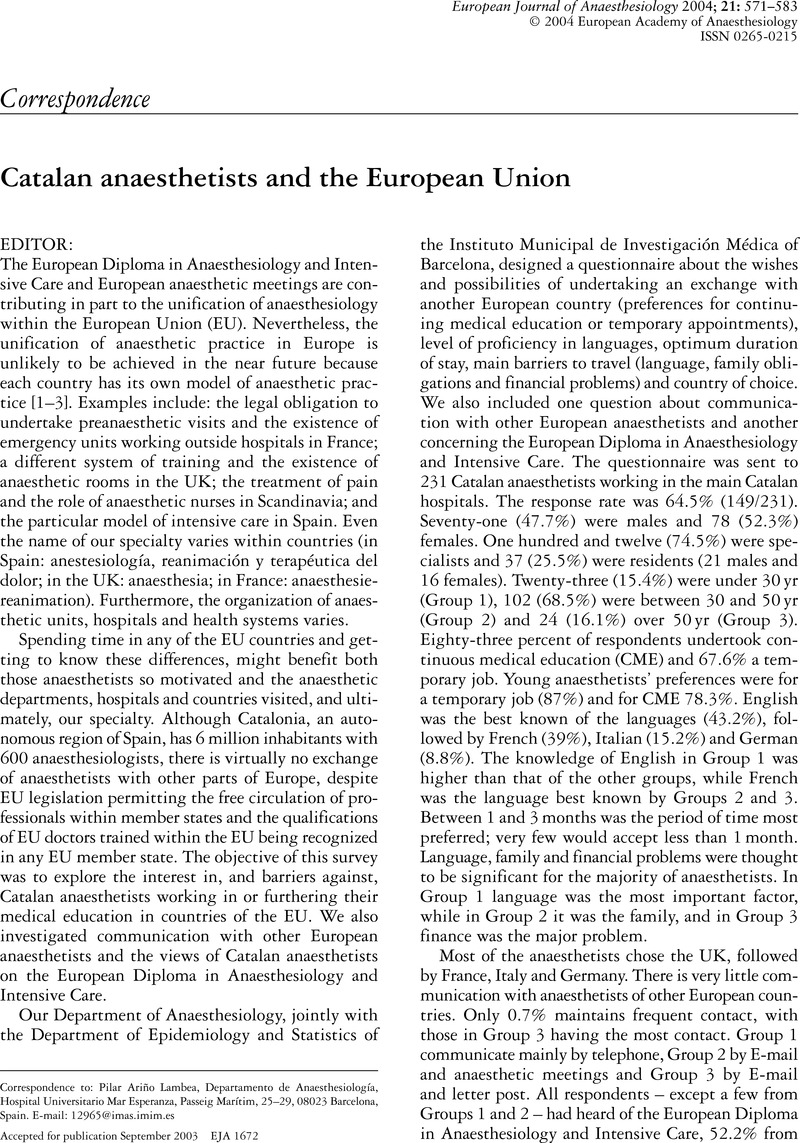Crossref Citations
This article has been cited by the following publications. This list is generated based on data provided by Crossref.
Krivosic-Horber, R.
Dépret, T.
and
Stojkovic, T.
2006.
Anesthésie et myopathies.
EMC - Anesthésie-Réanimation,
Vol. 3,
Issue. 3,
p.
1.
Krivosic-Horber, R.
Dépret, T.
and
Stojkovic, T.
2006.
Anestesia y miopatías.
EMC - Anestesia-Reanimación,
Vol. 32,
Issue. 4,
p.
1.
Boushra, Nader N.
and
Muntazar, Muhammad
2006.
Review article: The role of statins in reducing perioperative cardiac risk: physiologic and clinical perspectives.
Canadian Journal of Anesthesia/Journal canadien d'anesthésie,
Vol. 53,
Issue. 11,
p.
1126.
Guis, S.
Figarella‐branger, D.
Mattei, J. P.
Nicoli, F.
Le Fur, Y.
Kozak‐Ribbens, G.
Pellissier, J. F.
Cozzone, P. J.
Amabile, N.
and
Bendahan, D.
2006.
In vivo and in vitro characterization of skeletal muscle metabolism in patients with statin‐induced adverse effects.
Arthritis Care & Research,
Vol. 55,
Issue. 4,
p.
551.
Laing, Nigel G.
Sewry, Caroline A.
and
Lamont, Phillipa
2007.
Myopathies.
Vol. 86,
Issue. ,
p.
1.
Baker, Steven K.
and
Samjoo, Imtiaz A.
2008.
A Neuromuscular Approach to Statin-Related Myotoxicity.
Canadian Journal of Neurological Sciences / Journal Canadien des Sciences Neurologiques,
Vol. 35,
Issue. 1,
p.
8.
Baker, Steven K.
Vladutiu, Georgirene D.
Peltier, Wendy L.
Isackson, Paul J.
and
Tarnopolsky, Mark A.
2008.
Metabolic Myopathies Discovered During Investigations of Statin Myopathy.
Canadian Journal of Neurological Sciences / Journal Canadien des Sciences Neurologiques,
Vol. 35,
Issue. 1,
p.
94.
Hattori, Takayuki
Saito, Kuniaki
Takemura, Masao
Ito, Hiroyasu
Ohta, Hirotoshi
Wada, Hisayasu
Sei, Yoshitatsu
Kawamura, Mitsunobu
and
Seishima, Mitsuru
2009.
Statin-Induced Ca<sup>2+</sup> Release was Increased in B Lymphocytes in Patients who Showed Elevated Serum Creatine Kinase During Statin Treatment.
Journal of Atherosclerosis and Thrombosis,
Vol. 16,
Issue. 6,
p.
870.
Ghatak, Abhijit
Faheem, Osman
and
Thompson, Paul D.
2010.
The genetics of statin-induced myopathy.
Atherosclerosis,
Vol. 210,
Issue. 2,
p.
337.
Hopkins, P.M.
2011.
Malignant hyperthermia: pharmacology of triggering.
British Journal of Anaesthesia,
Vol. 107,
Issue. 1,
p.
48.
Laing, Nigel G.
2012.
Genetics of neuromuscular disorders.
Critical Reviews in Clinical Laboratory Sciences,
Vol. 49,
Issue. 2,
p.
33.
Nowak, Kristen J.
Lamont, Phillipa J.
and
Laing, Nigel G.
2013.
Muscle Disease.
p.
39.
Hedenmalm, Karin
Granberg, Arzu Gunes
and
Dahl, Marja-Liisa
2015.
Statin-induced muscle toxicity and susceptibility to malignant hyperthermia and other muscle diseases: a population-based case-control study including 1st and 2nd degree relatives.
European Journal of Clinical Pharmacology,
Vol. 71,
Issue. 1,
p.
117.
Dalmas, A.-F.
Krivosic-Horber, R.
and
Ducloy-Bouthors, A.-S.
2015.
Prise en charge des maladies rares en anesthésie et analgésie obstétricales.
p.
347.
Cui, Xu-lei
Wang, Ying-lin
Tan, Gang
Luo, Ai-lun
and
Guo, Xiang-yang
2016.
Low-dose Simvastatin Increases Skeletal Muscle Sensitivity to Caffeine and Halothane.
Chinese Medical Sciences Journal,
Vol. 31,
Issue. 2,
p.
107.
Oprea, Adriana D.
2018.
Perioperative Assessment of the Maxillofacial Surgery Patient.
p.
709.
Litman, Ronald S.
Griggs, Sarah M.
Dowling, James J.
and
Riazi, Sheila
2018.
Malignant Hyperthermia Susceptibility and Related Diseases.
Anesthesiology,
Vol. 128,
Issue. 1,
p.
159.
Gonzalez, Asensio
Iles, Tinen L.
Iaizzo, Paul A.
and
Bandschapp, Oliver
2020.
Impact of statin intake on malignant hyperthermia: an in vitro and in vivo swine study.
BMC Anesthesiology,
Vol. 20,
Issue. 1,
Crisan, Elena
and
Patil, Vijaya K.
2020.
Neuromuscular Complications of Statin Therapy.
Current Neurology and Neuroscience Reports,
Vol. 20,
Issue. 10,
Belani, Kumar
and
Berman, David J
2023.
Malignant Hyperthermia: A Review.
Journal of Acute Care,
Vol. 1,
Issue. 3,
p.
135.



